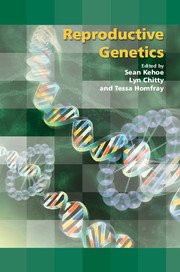Book contents
- Frontmatter
- Contents
- Participants
- Declarations of personal interest
- Preface
- 1 Genetic aetiology of infertility
- 2 Disorders of sex development
- 3 Preimplantation genetic diagnosis: current practice and future possibilities
- 4 Ethical aspects of saviour siblings: procreative reasons and the treatment of children
- 5 Epigenetics, assisted reproductive technologies and growth restriction
- 6 Fetal stem cell therapy
- 7 Prenatal gene therapy
- 8 Ethical aspects of stem cell therapy and gene therapy
- 9 Fetal dysmorphology: the role of the geneticist in the fetal medicine unit in targeting diagnostic tests
- 10 Fetal karyotyping: what should we be offering and how?
- 11 Non-invasive prenatal diagnosis: the future of prenatal genetic diagnosis?
- 12 Non-invasive prenatal diagnosis for fetal blood group status
- 13 Selective termination of pregnancy and preimplantation genetic diagnosis: some ethical issues in the interpretation of the legal criteria
- 14 Implementation and auditing of new genetics and tests: translating genetic tests into practice in the NHS
- 15 New advances in prenatal genetic testing: the parent perspective
- 16 Informed consent: what should we be doing?
- 17 Consensus views arising from the 57th Study Group: Reproductive Genetics
- Index
5 - Epigenetics, assisted reproductive technologies and growth restriction
Published online by Cambridge University Press: 05 February 2014
- Frontmatter
- Contents
- Participants
- Declarations of personal interest
- Preface
- 1 Genetic aetiology of infertility
- 2 Disorders of sex development
- 3 Preimplantation genetic diagnosis: current practice and future possibilities
- 4 Ethical aspects of saviour siblings: procreative reasons and the treatment of children
- 5 Epigenetics, assisted reproductive technologies and growth restriction
- 6 Fetal stem cell therapy
- 7 Prenatal gene therapy
- 8 Ethical aspects of stem cell therapy and gene therapy
- 9 Fetal dysmorphology: the role of the geneticist in the fetal medicine unit in targeting diagnostic tests
- 10 Fetal karyotyping: what should we be offering and how?
- 11 Non-invasive prenatal diagnosis: the future of prenatal genetic diagnosis?
- 12 Non-invasive prenatal diagnosis for fetal blood group status
- 13 Selective termination of pregnancy and preimplantation genetic diagnosis: some ethical issues in the interpretation of the legal criteria
- 14 Implementation and auditing of new genetics and tests: translating genetic tests into practice in the NHS
- 15 New advances in prenatal genetic testing: the parent perspective
- 16 Informed consent: what should we be doing?
- 17 Consensus views arising from the 57th Study Group: Reproductive Genetics
- Index
Summary
Epigenetics: overview
Epigenetics is both heritable and a reversible interaction on the DNA, resulting in a change in expression or phenotype without altering the DNA sequence. Epigenetic effectors include the modification of DNA by methylation, the configuration and modification of nucleosomal histone proteins and the involvement of antisense RNA molecules. Epigenetics, in association with the transcriptional apparatus, regulates transcriptional profiles which dictate changes in cellular phenotype, controlling cell differentiation, division and death.
During mammalian development, a specific mechanism of epigenetic regulation is in place that acts on a small number of genes controlling some aspects of fetal growth and development and postnatal behaviour. This mechanism, known to involve approximately 100 genes in the mouse genome and 50 genes in the human genome, is characterised by parent-of-origin-specific monoallelic expression, and is known as genomic imprinting (see www.otago.ac.nz/IGC).
Genomic imprinting
Genomic imprinting was discovered in 1984 by pronuclear transfer experiments. Bipaternal and bimaternal embryos were created in parallel to reveal opposite lethal phenotypes. The genomes inherited from the mother and the father during sexual reproduction were found to be asymmetrical, and each indispensible in normal development (Figure 5.1).
Naturally occurring examples of these phenotypes can be found in humans and they are also incompatible with life. Ovarian teratomas are equivalent to gynogenotes and are characterised by varying stages of developing embryonic tissues, which are grossly disorganised. Hydatidiform moles are equivalent to androgenotes and take the form of overgrown and cystic trophoblast tissue, which can become highly invasive.
Keywords
- Type
- Chapter
- Information
- Reproductive Genetics , pp. 71 - 82Publisher: Cambridge University PressPrint publication year: 2009



